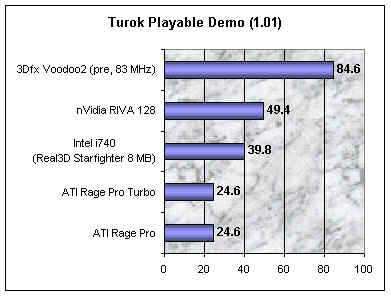3D Accelerator Review Step One - 3D Performance, the Real Deal
Turok TMARK - Cyrix/IBM 6x86MX PR200
Running TMARK with a low end 3D CPU shows the world a lot different. The biggest surprise is Quantum3D's Obsidian 100SB. This amazing high tech card is let down completely by the 6x86MX. A card that can reach highest frame rates requires one important thing: a CPU that feeds it with data fast enough. In case of the 6x86MX the Obsidian can be as fast as it wants, the CPU just wouldn't let it run. Due to the fact that the Obsidian was not overclocked as the other two Voodoo cards were, it performs even worse than a Pure3D or a Monster3D which doesn't even cost 1/8 of it. It is reassuring to realize that someone that spends over $700 or even $1600 for a 3D accelerator will certainly not buy a 6x86MX CPU.
Going through the results shows that Voodoo and it's Glide engine still rules, then there are the Direct3D kings with NVidia RIVA chip again, but after that it's different to above. Hercules' Stingray 128/3D with Voodoo Rush chip shows that it's a good choice for a low end 3D CPU, offering >25 fps and hence playability. However the overclocked Thriller3D is right behind it and may be even a better choice as we'll see further down. After that there are the Voodoo cards under Direct3D and in between the two cards with Rendition's Verite 2x00 chip, both at the same chip speed of 62.6 MHz and with the same performance. The PowerVR chip performs worse than above, something that's quite known, and please let's just not talk about ATI's Rage Pro ... it's just a shame. The SiS 6326 card was running at something like 10s per frame, so that I canceled the test.
Image Quality - Turok TMARK
As if you had expected it, Turok looks best with 3Dfx Voodoo and Voodoo Rush under the Glide engine. The only chip that comes close in image quality is Rendition's Verite 2x00, as found in Diamond's Stealth II S220 and Hercules new Thriller 3D. After that it's quite surprising to see how well Turok looks with Diamond's Fire GL 1000 Pro, who have obviously the best Permedia 2 driver currently available. Elsa's Winner/Office 2000 does almost look the same, but it shows some ugly rasterization of the smoke that occurs when shooting somebody. NVidia's RIVA offers a decent image quality, but it's not as beautyful as Turok could look, the PowerVR has some serious problem with the sky and its transparency. The worst image quality is offered by the ATI Rage Pro cards, and that even though Turok has a special engine for it. The biggest surprise is the SiS6326 card, which shows a very pretty image quality
Conclusion - Turok TMARK
We've got to face it, Voodoo still rules. When a game comes with Glide support (and which game dares not to nowadays?) it performs and looks best on Voodoo, regardless if you've got a fast or a slow CPU. This will probably only change a little bit in the future, instead of 'Voodoo rules' is will be 'Voodoo 2 rules'. Games that indeed only support Direct3D perform best on 3D accelerators with NVidia's RIVA 128 chip, closely followed by Rendition's Verite 2x00 family. If higher image quality is worth the few less fps to you, consider buying a Thriller3D, the Verite looks definitely better than the RIVA. For owners of systems with weak 3D performing CPUs the Hercules Stingray 128/3D may be worth considering as well, because its Voodoo Rush performs pretty well in those systems and it offers Voodoo top image quality. However those systems would benefit just as well from a Diamond Stealth II S220, which is considerably cheaper. Cards with 3DLabs Permedia 2 chip aren't really that great for gaming and are only interesting for people that have their second or third priority on 3D gaming. The PowerVR is clearly outperformed by other solutions in Direct3D, so that one rather goes for a 2D/3D card than for this only 3D add-on solution. Last but not least there's the ATI Rage Pro. I would say that you also shouldn't have a high priority on games when you want to buy this card. Some games run fine and fast on it, but it seems to have some serious Direct3D problems, as this test clearly showed.
Get Tom's Hardware's best news and in-depth reviews, straight to your inbox.
Current page: Turok TMARK - Cyrix/IBM 6x86MX PR200
Prev Page Turok TMARK AMD K6 233 Next Page GLQuake BIGASS1 Benchmark